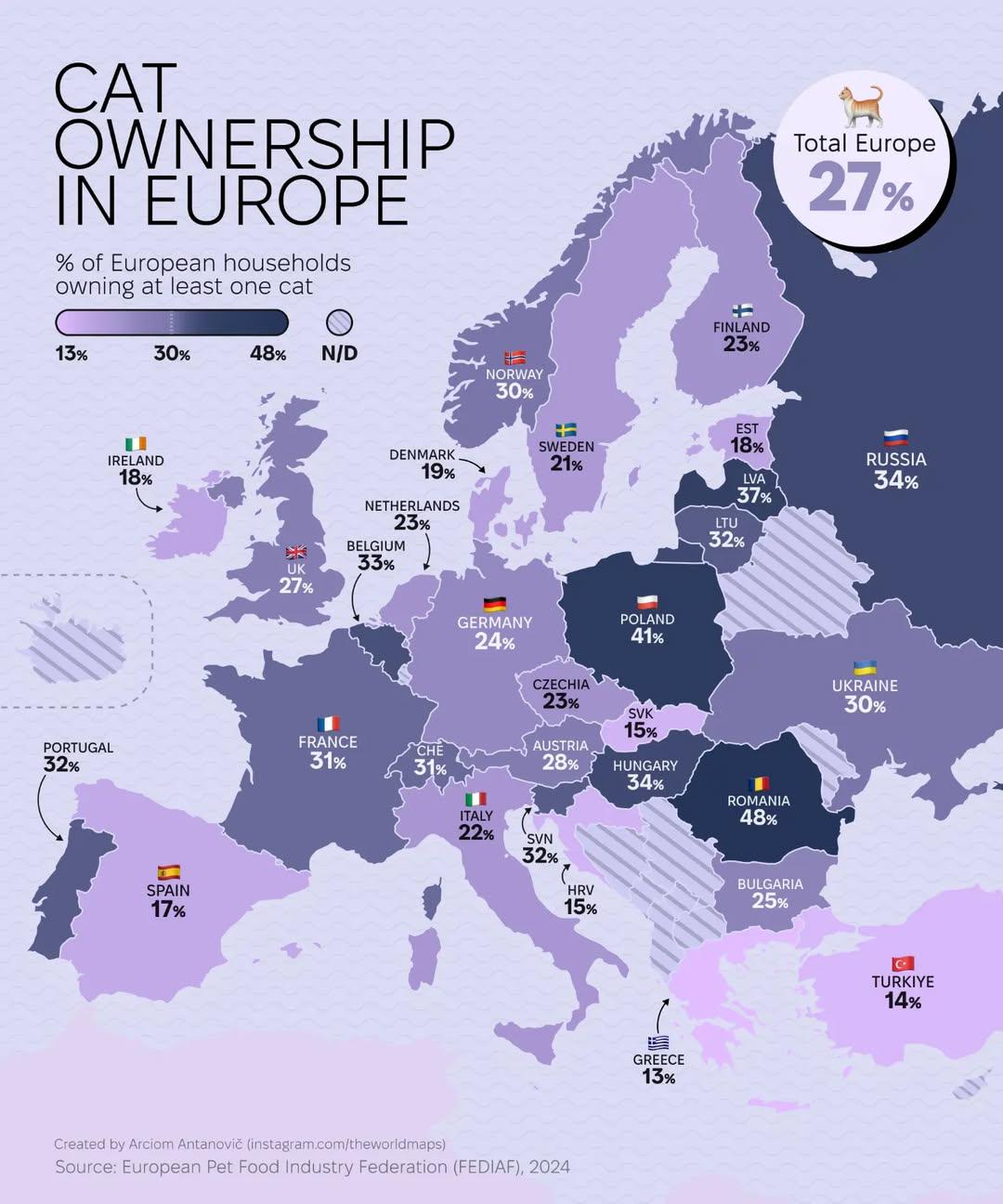Cat Ownership in Europe Map


Marcus Rodriguez
Historical Geography Expert
Marcus Rodriguez specializes in historical cartography and geographic data analysis. With a background in both history and geography, he brings unique...
Geographic Analysis
What This Map Shows
The "Cat Ownership in Europe Map" provides a detailed visualization of cat ownership rates across various European countries. By illustrating the percentage of households that own cats, this map serves as a valuable resource for understanding pet ownership trends in Europe. As we dive into the subject of cat ownership, we find that it reflects not only cultural attitudes towards pets but also socioeconomic factors and urban living conditions.
Deep Dive into Cat Ownership Trends
Interestingly, cat ownership in Europe has seen significant variations over the years. Statistically, Europe is home to approximately 100 million pet cats, with the highest concentrations found in households in countries like France, Germany, and Russia. What's fascinating is that cats are often preferred over dogs in many European nations, primarily due to their independent nature and lower maintenance requirements compared to dogs.
In countries like France, around 30% of households own at least one cat, making it one of the highest rates in Europe. This preference can be attributed to a cultural appreciation for cats, which are often seen as symbols of companionship without the obligations that come with dog ownership. Moreover, urban areas tend to have higher cat ownership rates, as cats are well-suited for apartment living and require less outdoor space compared to dogs.
The reasons for owning cats also vary among different demographics. For instance, young professionals in bustling cities may opt for cats due to their adaptability and lower need for constant attention. Conversely, families with children may appreciate the playful nature of cats and the lessons in responsibility they can provide to young ones. Economic factors also come into play; in regions with higher income levels, pet ownership tends to be more common, as families can afford the costs associated with pet care, including food, veterinary services, and grooming.
Interestingly, the rise of social media and the Internet has also contributed to the increasing popularity of cats in Europe. Cat-themed content has become a staple on platforms like Instagram and TikTok, leading to a greater public fascination with various cat breeds and quirky feline behaviors. This trend has not only heightened interest in cat adoption but has also fostered significant community engagement around cat welfare and rescue initiatives.
Regional Analysis
When we break down the map regionally, we see distinct patterns emerge. Northern European countries such as Sweden and Finland boast ownership rates above 25%, likely influenced by their colder climates where indoor pets are more practical. In contrast, Southern European nations like Spain and Italy exhibit slightly lower rates, hovering around the 20% mark. Cultural traditions and lifestyle choices play a significant role in these differences. For instance, the warmer climates in Southern Europe encourage more outdoor activities, which may lead to a preference for dogs.
Moreover, in Eastern Europe, countries like Poland and Hungary present varied data, with ownership rates close to 15-20%. Economic factors are pivotal here; as these nations continue to develop economically, pet ownership rates are expected to rise. Urban centers in these countries often show higher ownership, suggesting a shift in societal attitudes towards pets as symbols of comfort and companionship.
Interestingly, the United Kingdom stands out with approximately 26% of households owning cats, reflecting a long-standing cultural affinity for these animals. This trend indicates not only a love for pets but also changing attitudes towards animal welfare and adoption.
Significance and Impact
Understanding cat ownership trends in Europe is crucial for several reasons. Firstly, these statistics highlight the evolving relationship between humans and pets, revealing insights into societal values and lifestyle choices. Countries with high cat ownership rates often demonstrate a commitment to animal welfare, with various organizations working tirelessly to promote pet adoption and responsible ownership.
Additionally, higher ownership rates can influence pet-related industries, including pet food, veterinary care, and accessories. As more households welcome cats into their homes, businesses are likely to adapt by offering specialized products and services that cater to feline needs.
Looking ahead, projections suggest that cat ownership in Europe will continue to rise, driven by urbanization, changing family structures, and increased awareness of animal welfare. Interestingly, this trend could also lead to more initiatives aimed at responsible pet ownership, stray cat management, and public education about the benefits of adopting pets. As we step into the future, it will be fascinating to observe how these trends evolve and shape our societies.
In conclusion, the "Cat Ownership in Europe Map" not only provides a visual representation of where cats are most commonly kept but also invites us to ponder the broader implications of pet ownership in our lives. With cats becoming increasingly integral to our daily experiences, understanding their place in European households is more important than ever.
Visualization Details
- Published
- October 12, 2025
- Views
- 48
Comments
Loading comments...